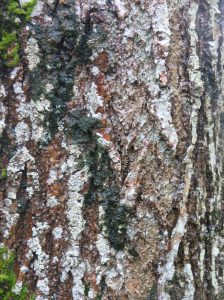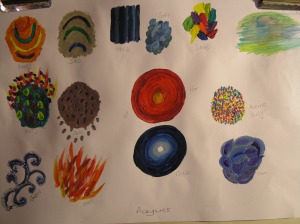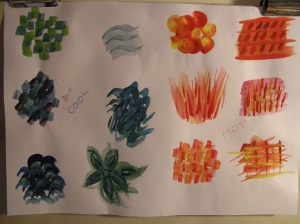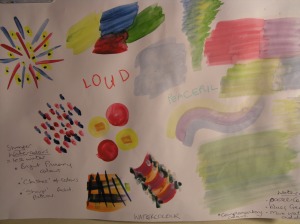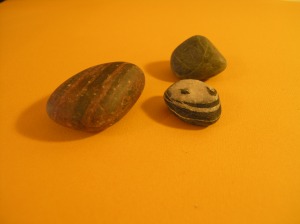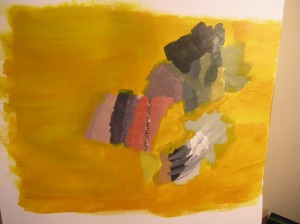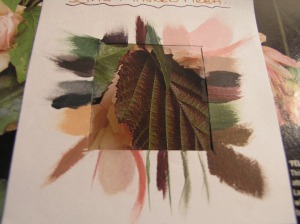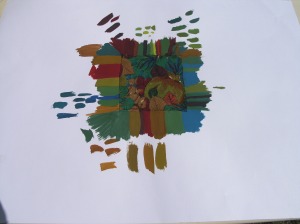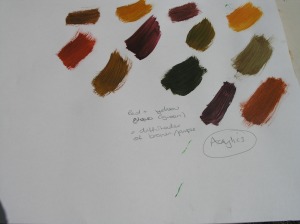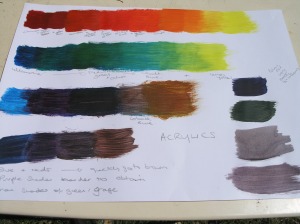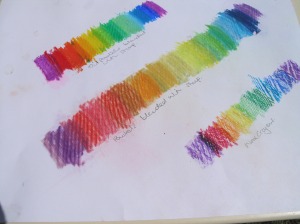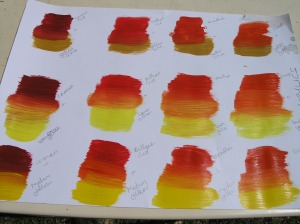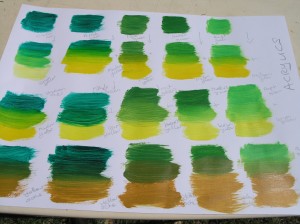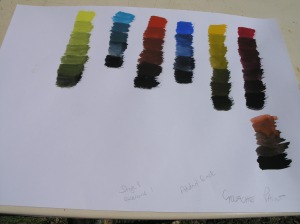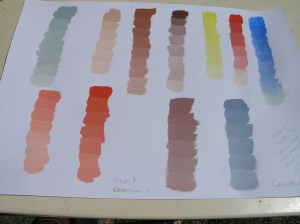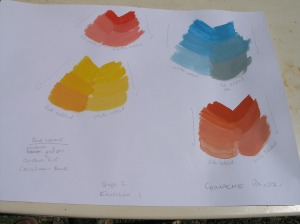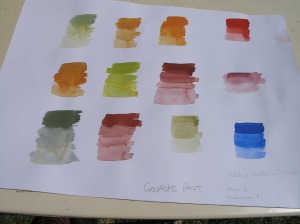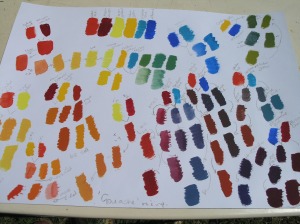I was not looking forward to this exercise in many respects , having done quite a lot of embroidery over the years I was concerned it may become laborious. At first it did appear to be that way. After a flourish of samples it was put aside until wimbledon! The excuse to sit; there was no excuse not to finish it.
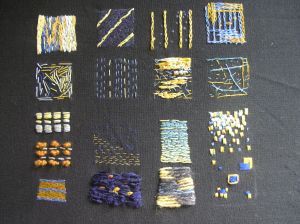
I had started this exercise with a thicker cotton thread and simple running stitch. Building geometric blocks with organised stitching.
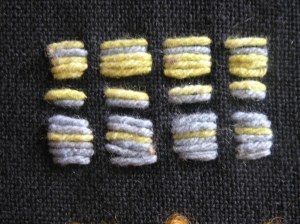
The light blue made the yellow recede when dominating the block and the effect was similar for the yellow making the blue recede when the roles were reversed and the yellow was dominating. However when worked on a one to one, equal basis the yellow still managed to create this effect pushing the blue into the background, Dulling its appearance slightly. Although the effect was not as pronounced as in other samples and when building blocks of colour.

Seeing the effects from the previous sample I was expecting the blue to recede into the background however, the thickening of the thread and a darker shade emphasized this even more. The effect had potential to be exploited for textural work. An example using the bark formations of trees
Working bands of blue seemed to behave differently. They dominated slightly pushing the yellow back this time.

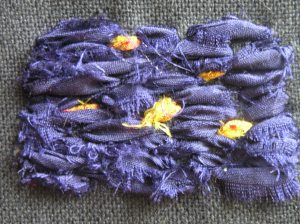
Using the research that I had made from that sampler, blue was then used as the background for a single yellow stitch, This showed how the yellow still managed to be significant when using colours of equal intensity. Was this because they were intensely saturated hues? would the effects alter with less intense saturated hues?
Spaced out lines of equal intensity thin threads random and regular.
When thinner threads, wider spaced were used so the background was visible the blue seemed insignificant and did appear to recede to be barely visible. I had used a organised stitch for the yellow which did give more solidity to the colour too. The random placement of the blue thread was of equal intensity but appeared lighter and lacked solidity. Previous samples had already highlighted the readiness of yellow to dominate unless the blue was in a block.Then it became a contender for domination. I felt perhaps the random stitch contributed to the lack of definition and competition with the yellow too.

Although by organizing the blue thread in lines, providing more blocks of colour the yellow was still able to push forward sunny and cheerful! Why?
Returning to my research,

The lighter blues held their position with all the yellows. However, as the hue became more intensely saturated it receded again until the darkest was insignificant despite there being no solid block this time, supporting my research.
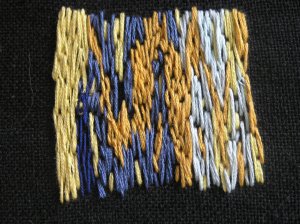
This time exploring the previous outcomes of working the colours in solid blocks against each other I also explored whether different intensities affected the outcome dramatically. Here you can see the colours fought for supremacy! The blue being able to even appear in the forefront even though it was still more effective again – the less the saturation. Perhaps the random stitching played its part….

At first this appears more organised but can you see how I have been cheeky doubling two experiments… I have indeed made solid blocks but craftily done that by a trick of an eye. The lines have been worked both close together and wider apart illustrating the ability to create illusions by careful use of colour. At the bottom the blue is almost unnoticeable. Any use of blue is thin lines and sandwiched between the yellow we already know to be the dominant colour. So en masse it appears yellow. It is not before nearly the top of the sample the blue is able to match the dominance and even then struggles until a solid block in its own right.

Using solid blue/yellows but changing the yarn to a thicker matt effect wool that did not reflect the light, reducing the luminosity gave the blue more substance quite literally. This discovery could be used to an advantage in my work.

With all that I have learnt so far, I gave the colours the chance to show off their full complementary potential by working this sample with an intensely saturated blue silk formed in a block form with no background showing and thinner lines of yellow. The yellow stood out as if above the surface whilst the blue took back stage – It allowed the yellow to sing!

This experiment was almost a foregone conclusion as the background was black and gave a very similar effect to the block of blue in the previous sample. However, I felt the previous sample was more intense and gave more prominence to the yellow bands yet the blue had a presence too. In this sample the blue played a relatively insignificant part, perhaps adding a texture rather than a colour value. I did like the effect achieved and could see its potential as a way of bringing textures into a piece of work perhaps adding other colours carefully selected from my experiments in the next exercises.
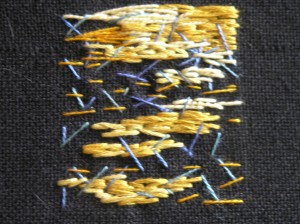
Using paler colours of the yellows and slightly stronger ones of the blues but working them differently I was able to see how this could play an instrumental way in achieving even more textures in more work. The blues faired better and became an interesting participant, not allowing the yellow to steal centre stage. They contributed a lovely effect of their own not comparable to the yellow. The yellow still had much to offer. Some of the blue stitches were oversewn by the yellow in the process and some laid on top. Those laiod on top resumed a recedent postion again as before but when grouped loosely together created a unique texture. Definitely another way to exploit their colour properties in textiles.
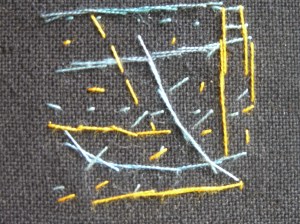
By working with the information I had gained from the previous samples I was able to work another sample supporting my findings and confirming the ability to manipulate the effects to my advantage when working. I increased the luminosity of the blue but this meant a less intense hue. I then increased the intensity of the yellow, subtly playing with the chemistry? The 2 hues were now closer together resulting in a more equal dominance. The use of the ‘lighter’ blues brought them into play more. The contrast in the sample from the other samples where the differences were highlighted was very evident. I now knew how to provide both colours in equal intensities, very useful sometimes in my work.

Again making a sample reflecting a few of the ideas blocks and space this time in an organised pattern for both colours I experimented altering the stitch to chain stitch. Whilst the blue did start to receded slightly, the solid colour managed to absorb the yellow in the bottom right, creating a less intense colour. Where the roles were reversed the blue top right seemed to change too.
By this time I had pursued more research into artists, reading and looking at the way they used colour. By trying to explore this in the small sample squares it became more interesting.
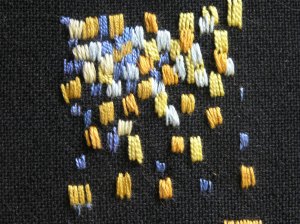
Painting by stitch whilst reading about Cezanne, an artist I had always felt drawn too. He worked by applying small brushstrokes of colour that became blocks, allowing the eye to blend and colour mix. I worked on the principle in stitch working different shades of blue and yellow of similar thicknesses close together in blocks of 4 strands or stitches per block. I really liked this effect and the blending happened by magic. I could see how strong images could be built up for future work with this technique. It was giving a wonderful texture and life to the sample and I found it invigorating. Definitely a technique I plan to use.

My final sample I asked what, if and how different combinations of the colours in the blocks were affected by each other. I made this sample with blue and yellow of equal intensity and similar properties in the threads – thickness, cotton/silk. When the small single blocks were moved it affected the colours with the blue gaining a grey tinge to it when moved away from the yellow, perhaps needing to compensate for some of the background/yellow differences? It was not as pronounced when moved closer to the yellow (bottom right) although it did seem to be still affected.


